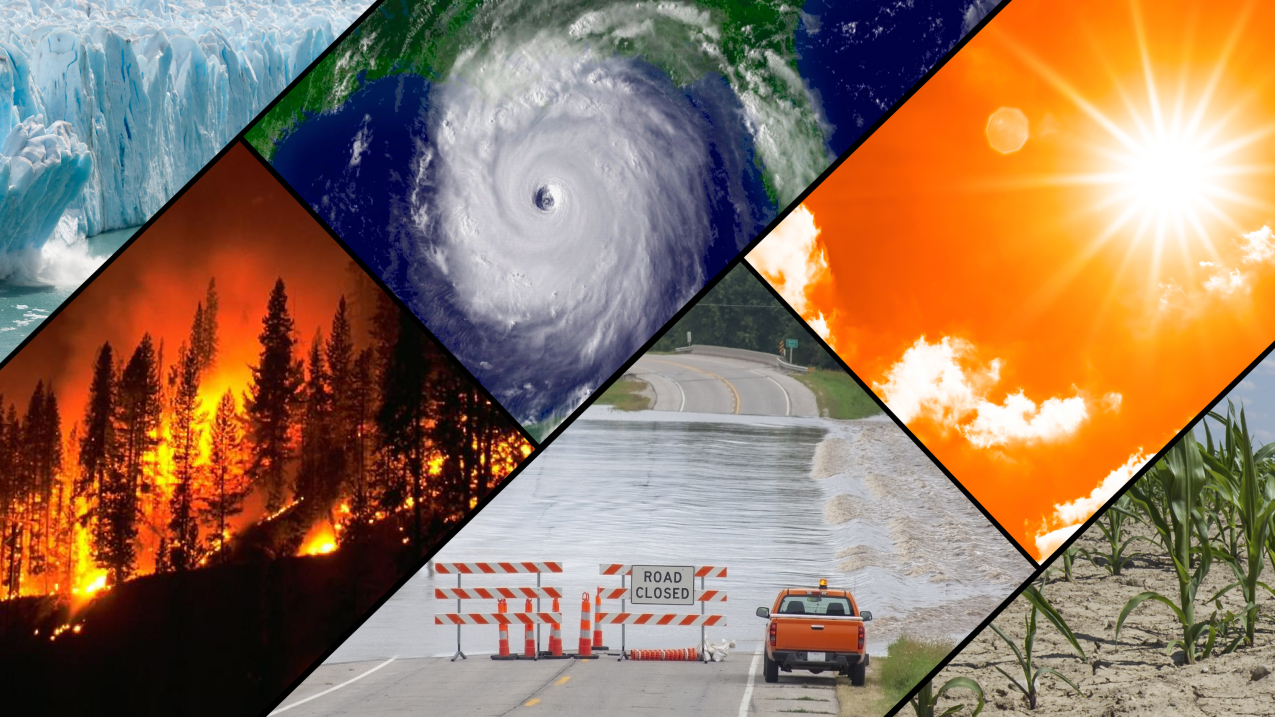Climate change impacts
Though we often think about human-induced climate change as something that will happen in the future, it is an ongoing process. Ecosystems and communities in the United States and around the world are being impacted today.

A collage of typical climate and weather-related events: floods, heatwaves, drought, hurricanes, wildfires, and loss of glacial ice. (NOAA)
Global temperatures rose about 1.98°Foffsite link (1.1°C) from 1901 to 2020, but climate change refers to more than an increase in temperature. It also includes sea level rise, changes in weather patterns like drought and flooding, and much more. Things that we depend upon and value — water, energy, transportation, wildlife, agriculture, ecosystems, and human health — are experiencing the effects of a changing climate.
The impacts of climate change on different sectors of society are interrelated. Drought can harm food production and human health. Flooding can lead to disease spread and damage to ecosystems and infrastructure. Human health issues can increase mortality, impact food availability, and limit worker productivity. Climate change impacts are seen throughout every aspect of the world we live in. However, climate change impacts are uneven across the country and the world — even within a single community, climate change impacts can differ between neighborhoods or individuals. Long-standing socioeconomic inequities can make underserved groups, who often have the highest exposure to hazards and the fewest resources to respond, more vulnerable.
The projections of a climate change-impacted future are not inevitable. Many of the problems and solutions offsite link are known to us now, and ongoing research continues to provide new ones. Experts believe there is still time to avoid the most negative of outcomes by limiting warming offsite links and reducing emissions to zero as quickly as possible. Reducing our emissions of greenhouse gases will require investment in new technology and infrastructure, which will spur job growth. Additionally, lowering emissions will lessen harmful impacts on human health, saving countless lives and billions of dollars in health-related expenses.
Our changing climate
We see climate change affecting our planet from pole to pole. NOAA monitors global climate data and here are some of the changes NOAA has recorded. You can explore more at the Global Climate Dashboard. Global temperatures rose about 1.8°F (1°C) from 1901 to 2020.
Sea level rise has accelerated from 1.7 mm/year throughout most of the twentieth century to 3.2 mm/year since 1993.
Glaciers are shrinking: the average thickness of 30 well-studied glaciers has decreased more than 60 feet since 1980.
The area covered by sea ice in the Arctic at the end of summer has shrunk by about 40% since 1979.
The amount of carbon dioxide in the atmosphere has risen by 25% since 1958, and by about 40% since the Industrial Revolution.
Snow is melting earlier compared to long-term averages.
Changes to water resources can have a big impact on our world and our lives.
Flooding is an increasing issue as our climate is changing. Compared to the beginning of the 20th century, there are both stronger and more frequent abnormally heavy precipitation events across most of the United States.
Conversely, drought is also becoming more common, particularly in the Western United States. Humans are using more water, especially for agriculture. Much like we sweat more when it is hot out, higher air temperatures cause plants to lose or transpire, more water, meaning farmers must give them more water. Both highlight the need for more water in places where supplies are dwindling.
Snowpack is an important source of fresh water for many people. As the snow melts, freshwater becomes available for use, especially in regions like the Western United States where there is not much precipitation in warmer months. But as temperatures warm, there is less snow overall and snow begins to melt earlier in the year, meaning the snowpack may not be a reliable source of water for the entire warm and dry seasons.
Food
Our food supply depends on climate and weather conditions. Although farmers and researchers may be able to adapt some agricultural techniques and technologies or develop new ones, some changes will be difficult to manage. Increased temperatures, drought and water stress, diseases, and weather extremes create challenges for the farmers and ranchers who put food on our tables.
Human farm workers can suffer from heat-related health issues, like exhaustion, heatstroke, and heart attacks. Rising temperatures and heat stress can also harm livestock.
Climate change is already impacting human health. Changes in weather and climate patterns can put lives at risk. Heat is one of the most deadly weather phenomena. As ocean temperatures rise, hurricanes are getting stronger and wetter, which can cause direct and indirect deaths. Dry conditions lead to more wildfires, which bring many health risks. Higher incidences of flooding can lead to the spread of waterborne diseases, injuries, and chemical hazards. As the geographic ranges of mosquitoes and ticks expand, they can carry diseases to new locations.
The most vulnerable groups, including children, the elderly, people with preexisting health conditions, outdoor workers, people of colour, and people with low income, are at an even higher risk because of the compounding factors from climate change. But public health groups can work with local communities to help people understand and build resilience to climate change health impacts.
 Examples of populations at higher risk of exposure to adverse climate-related health threats are shown along with adaptation measures that can help address disproportionate impacts. When considering the full range of threats from climate change as well as other environmental exposures, these groups are among the most exposed, most sensitive, and have the least individual and community resources to prepare for and respond to health threats. White text indicates the risks faced by those communities, while the dark text indicates actions that can be taken to reduce those risks. (EPA (National Climate Assessment))
Examples of populations at higher risk of exposure to adverse climate-related health threats are shown along with adaptation measures that can help address disproportionate impacts. When considering the full range of threats from climate change as well as other environmental exposures, these groups are among the most exposed, most sensitive, and have the least individual and community resources to prepare for and respond to health threats. White text indicates the risks faced by those communities, while the dark text indicates actions that can be taken to reduce those risks. (EPA (National Climate Assessment))The enntvironme
Climate change will continue to have a significant impact on ecosystems and organisms, though they are not impacted equally. The Arctic is one of the ecosystems most vulnerable to the effects of climate change, as it is warming at least twice the rate of the global average, and melting land ice sheets and glaciers contribute a dramatically offsite link to sea level rise around the globe.
Some living things can respond to climate change; some plants are blooming earlier and some species may expand their geographic range. But these changes are happening too fast for many other plants and animals as increasing temperatures and changing precipitation patterns stress ecosystems. Some invasive or nuisance species, like lionfish and ticks, may thrive in even more places because of climate change.
Changes are also occurring in the ocean. The ocean absorbs about 30% of the carbon dioxide that is released into the atmosphere from the burning of fossil fuels. As a result, the water is becoming more acidic, affecting marine life. Sea levels are rising due to thermal expansion, in addition to melting ice sheets and glaciers, putting coastal areas at greater risk of erosion and storm surges.
The compounding effects of climate change are leading to many changes in ecosystems. Coral reefs are vulnerable to many effects of climate change: warming waters can lead to coral bleaching, stronger hurricanes can destroy reefs, and sea level rise can cause corals to be smothered by sediment. Coral reef ecosystems are home to thousands of species, which rely on healthy coral reefs to survive.
Infrastructure
Physical infrastructure includes bridges, roads, ports, electrical grids, broadband internet, and other parts of our transportation and communication systems. It is often designed to be in use for years or decades, and many communities have infrastructure that was designed without future climate in mind. But even newer infrastructures can be vulnerable to climate change.
Extreme weather events that bring heavy rains, floods, wind, snow, or temperature changes can stress existing structures and facilities. Increased temperatures require more indoor cooling, which can put stress on an energy grid. Sudden heavy rainfall can lead to flooding that shuts down highways and major business areas.
Nearly 40% of the United States population lives in coastal counties, meaning millions of people will be impacted by sea level rise. Coastal infrastructure, such as roads, bridges, water supplies, and much more, is at risk. Sea level rise can also lead to coastal erosion and high-tide flooding. Some communities are projected to possibly end up at or below sea level by 2100 and will face decisions around the managed retreat and climate adaptation.
Many communities are not yet prepared to face climate-related threats. Even within a community, some groups are more vulnerable to these threats than others. Going forward, communities need to invest in resilient infrastructure that will be able to withstand future climate risks. Researchers are studying current and future impacts of climate change on communities and can offer recommendations on best practices. Resilience education is vitally important for city planners, emergency managers, educators, communicators, and all other community members to prepare for climate change.
EDUCATION CONNECTION
Teaching about climate change can be a daunting challenge, but it is a critical field for students to learn about, as it affects many parts of society. The Essential Principles of Climate Literacy, developed by NOAA and other federal partners, are standards that create a framework for teaching climate. The Toolbox for Teaching Climate & Energy explores a learning process to help students engage in climate action in their own communities or on a global scale. For more educator support, NOAA offers professional development opportunities (including the Planet Stewards Program) on climate and other topics.
























